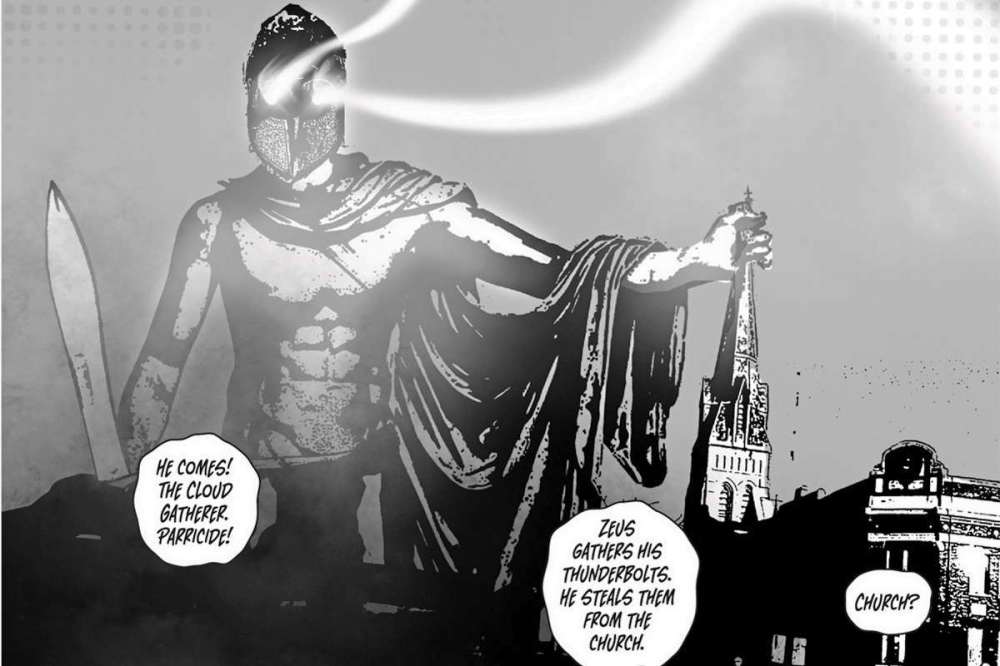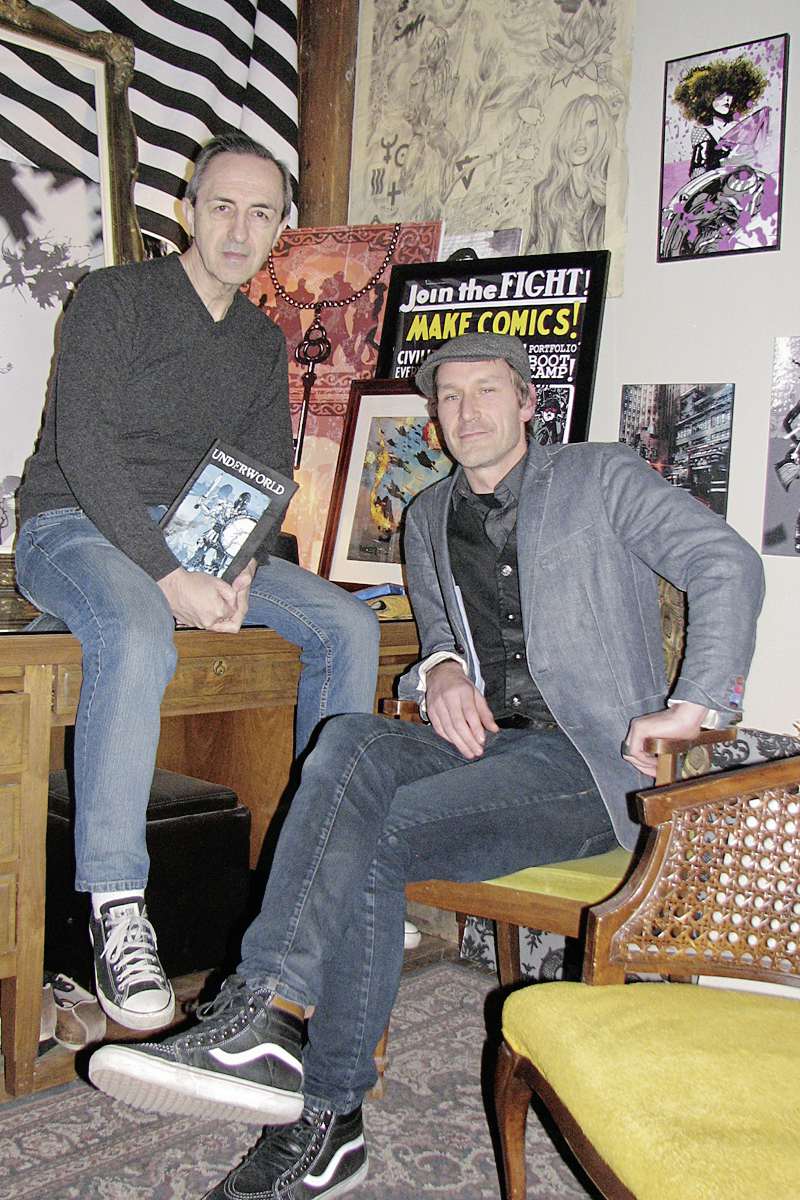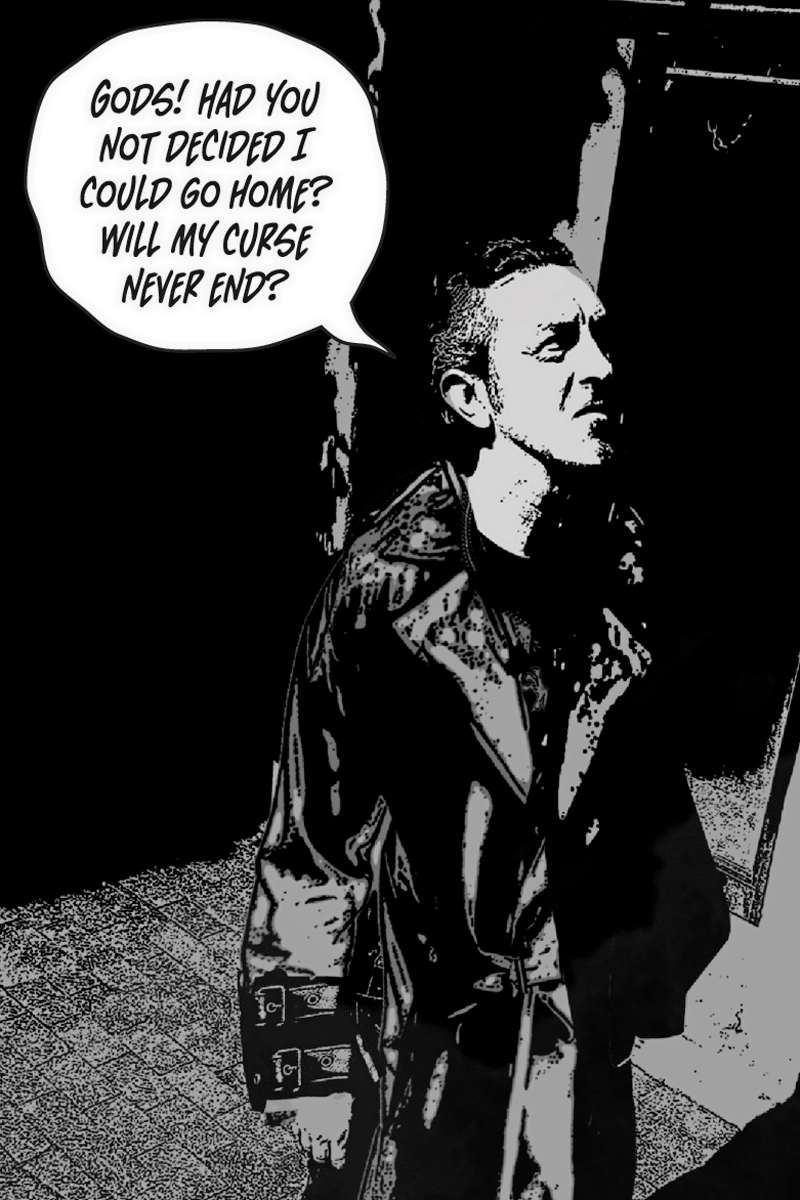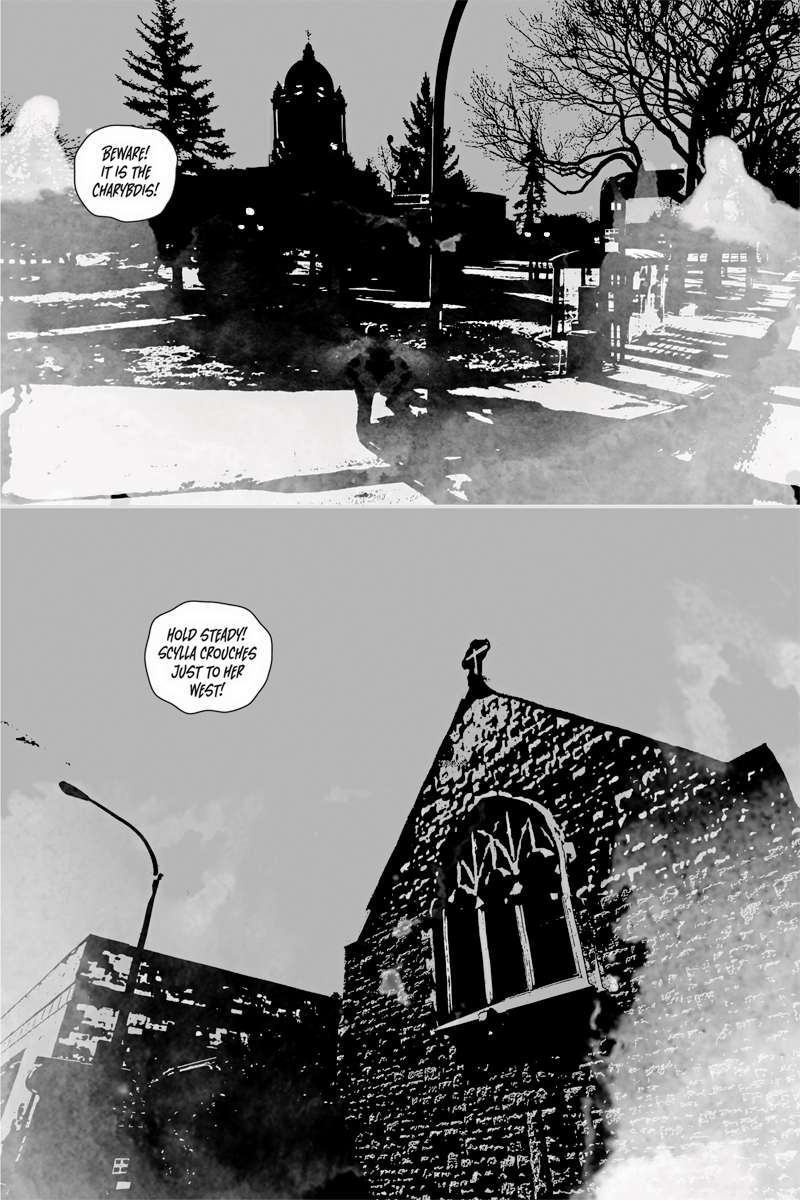Delighting in the work that suits them best
Winnipeg comics pros bring long-in-the-works project to fruition
Advertisement
Hey there, time traveller!
This article was published 18/11/2015 (3661 days ago), so information in it may no longer be current.
For years, Lovern Kindzierski wondered if his story infusing the journey of brave Odysseus into Winnipeg’s streets would ever be realized.
It may be that the Fates simply made him wait for the right creative partner.
After teaming up with fellow graphic novelist Gregory (GMB) Chomichuk, 38, Kindzierski’s tale, Underworld, has finally been put to paper and is being launched in Winnipeg at McNally Robinson Booksellers (1120 Grant Ave.) on Tues., Dec. 1.

The 130-page graphic novel, published by Alberta’s Renegade Arts Entertainment, tells the story of Hector Ashton, a man who awakens in the psych ward of St. Boniface Hospital convinced that he is the Odysseus of Homer’s eighth-century epic poem The Odyssey.
Ashton escapes, and as he wanders the city his mind interprets the shady characters he runs up against as figures from Greek lore: he finds Herakles partying in the city’s club district; a cop car’s spotlight becomes a cyclops’ baleful stare; deities grasp at the steeple of Osborne Village’s Augustine United Church.
The tale, penned by Fort Rouge resident Kindzierski, 61, makes use of The Odyssey’s enduring themes — the longing for home, the trials and tribulations of the world, and the powerful influence of fathers over sons.
Kindzierski first came up with the story in the late 1980s, during his years at the University of Manitoba — when he drew a connection between the city’s club scene of the day and Hades itself. His love of classical mythology stems back to childhood, when he would watch films such as The Giant of Marathon with his father. He studied classical mythology while pursuing his fine arts degree.
While at university, Kindzierski endured multiple tragedies.
“What do they say? The big stressors in your life are if you lose a parent, if you lose your marriage or if you lose your job, and I lost all three in the first year,” Kindzierski said.
These personal struggles helped him to see Homer’s epic, which he first encountered in elementary school, in a new light.
“I still was entertaining thoughts of getting back together with my wife. I’m doing that and I’m getting into the mythology classes and that, talking about different things in mythology, and suddenly a lot of that is coming up in my English classes and elements of it in my film classes, so I’m like ‘OK, it’s like the universe is pointing me in the direction of this story,”’ he said. “I’d never looked at it as just this guy trying to get back with his wife and kid.”
“Graphic novels is more akin to making music than anything else. The collaboration is strong. Someone is humming a tune, someone else is putting in rhythm. You don’t have the song without the whole band playing. There’s a song but if the drummer stops, the music stops.”
—GMB Chomichuk
Underworld began as a screenplay but, after he consulted with friends in the film community, including Guy Maddin, Kindzierski found the task of obtaining funds for the project “daunting.”
“I thought, ‘It’s in my back pocket if I have an opportunity to pitch it to somebody who has money.’ I did to a couple producers but nobody bit,” he said.
He later conceived the story as a graphic novel but Chomichuk, an Osborne Village resident, notes that at the time the comics industry wasn’t ready to take a gamble on such projects. While “alternative comics” were slowly gaining ground in the late ’80s, they were considered to have limited potential audiences.
“That was like, the realm of madmen and mavericks, right? Which is not too far from where we sit now,” Chomichuk said. “But, what you can do now pitching a publisher is say ‘We’re going to create something that’s for a niche,’ right?
“You didn’t do that then. Now we can target an audience more readily.”
Chomichuk’s graphic style brings a noir-ish mood to the proceedings. His portfolio includes time-travelling detective story Infinitum, launched this past July, as well as The Imagination Manifesto (nominated for a 2012 Aurora Award for best Canadian graphic novel), a work which first led Kindzierski to think he should collaborate with the Winnipeg artist.
“The Manifesto is so many different things. Some of the stuff I was looking at and going ‘This doesn’t work for me at all,’ and other stuff I was going ‘Oh, yeah I’ve got to talk to him about doing something together sometime.”
Chomichuk’s art style was exactly what Kindzierski had in mind when he conceived Underworld as a graphic novel .

“The way I pictured the book back in the ’80s, I was actually thinking of storyboarding it by using photographs and manipulating them,” Kindzierski said. “What I was trying to develop, he was already three books ahead of me on.”
Teaming up
After they began working on Underworld, the two took a walking tour of the city, visiting locales that would later wind up in the book.
“We walked a path that the character would take. We didn’t swim across the river but we entertained the idea,” Chomichuk said.
Chomichuk, realizing how personal the story was, told Kindzierski it was only fitting he play the lead role, and so he became the face of his own protagonist — though Kindzierski initially resisted.
“My rationale was that since a little thread of the story was autobiographical that it was OK, you could stand on it,” Chomichuk said.
While Kindzierski is credited as the book’s writer, and Chomichuk its artist, the process was collaborative from top to bottom. In a manner similar to what’s known as the ‘Marvel Method’ of creating comic books, Kindzierski contributed a rough breakdown of each page, which served as Chomichuk’s guide as he created the finished art. Kindzierski then finished the scripting after the art was complete. In the end, both contributed to the art and story.
“Graphic novels is more akin to making music than anything else. The collaboration is strong. Someone is humming a tune, someone else is putting in rhythm. You don’t have the song without the whole band playing. There’s a song but if the drummer stops, the music stops,” Chomichuk said.
Chomichuk, for example, often pushed for more fantastical elements. He’s long valued the symbolic power of monsters and wanted to include them in the book as much as possible.
“He’s saying ‘I want a monster’ and I’m saying ‘You can’t have a monster,’” Kindzierski adds.
“Yeah, ‘You can’t have a monster, not everything has to be a monster,’” Chomichuk said.
“If I’ve learned anything from this book, it’s that not everything has to be a monster. People are worse monsters.”
Join the fight — make comics
Chomichuk, who teaches art, drama, English and psychology at St. James Collegiate, takes great pleasure in educating others about the medium, hoping to get others in on the action.
On Nov. 14, he spent the day at A Muse N Games on Portage Avenue to lead a “Creating Comics” workshop for would-be graphic novellists. Chomichuk led the workshop with ChiGraphic, which has published his projects in the past.
“Part of it is a selfish letter to my past self,” he said of his motivation to teach the medium to others. “If I could tell someone sooner, show someone sooner, that there aren’t as many rules as they think, that there aren’t as many barriers as they think, and that there are way more opportunities than there have ever been… Part of me wanting to hold those workshops is that somebody will get a 15, 20-year head start that they don’t have to wait, or put it off, or wonder if they should.”

Kindzierski, too, spends time teaching the craft to a new generation: he runs a graphic novel course for at-risk teens through Red River College’s continuing education program. He also taught at the U of M during the summer.
“I see it in these kids. We had a government rep come by to interview the kids to make sure we’re doing something with them. After the class, she ended up talking to me for an hour because she was so impressed by them,” Kindzierski said.
“She was really impressed with how they had someplace to go now. And I don’t mean, come to my class, I mean they had a trajectory beyond that.”
Now that Underworld is finished, both men have plenty of irons in the fire.
Apart from Infinitum and Underworld, Chomichuk has also published Manitoba Book Award-winning children’s graphic novel Cassie and Tonk (written by Chomichuk and created/illustrated by Justin Currie) this year.
But his desk is still piled high with projects — a couple of all-ages books, a theatre production, an animation project and an adult graphic novel. Another graphic novel, Midnight City, is due to be published early next year. For him, finding time for it all on top of fatherhood and his duties as a teacher isn’t so hard.
“People say ‘How do you find the time to do that?’ I say, well, are you caught up on all the seasons of The Walking Dead? That’s about 60 hours that you could’ve done something else,” Chomichuk said.
Kindzierski is currently writing a trilogy called Shame, which pairs him with artist John Bolton, and he’s also developing a miniseries, Necromantic, for Renegade. On top of that, he’s putting his skills as a colourist to work on Dark Horse Comics’ six-issue miniseries This Damned Band, about a world-famous 1970s rock band which bites off more than it can chew when its devil worship goes a bit too far.

Both Kindzierski and Chomichuk say they intend to collaborate again, and both are as busy as ever, but is there ever a point at which you ‘make it’ in the comics business.
“You never ‘make it’ (in comics). You never ‘make it’ in anything. The moment you think you made it, you’re dead.” Chomichuk said.
“I think it’s when you get hauled up in front of the academy,” Kindzierski said.“
And they say ‘This is your lifetime achievement thing,’ and you go…”
“But I’m still alive!” Chomichuk adds.






